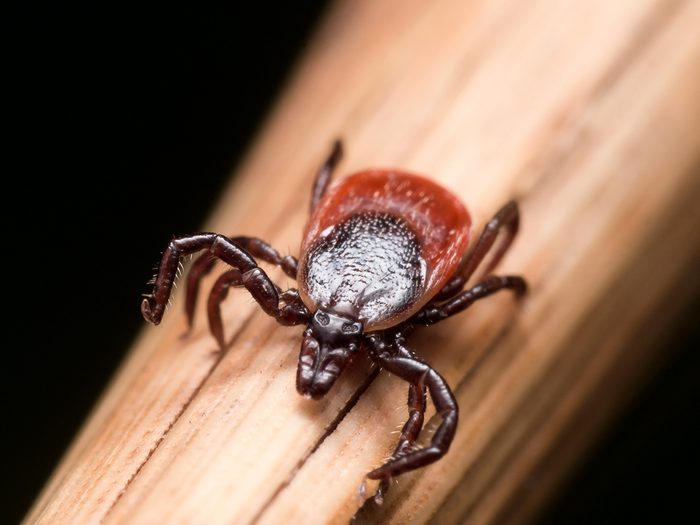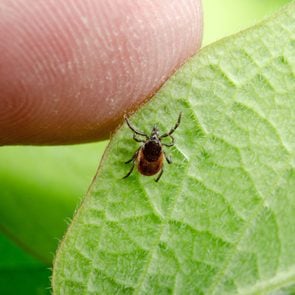How Ticks Became a Major Threat to Our Health

Some experts predict as many as 10,000 new cases of Lyme disease each year in the 2020s. Here's how one tiny bug became a threat to our health.
When Katie Clow arrives in her windowless lab at the Ontario Veterinary College, in Guelph, she often finds a pile of envelopes. Each one contains a slip of paper and a small plastic vial or two. The paperwork lists the name of a veterinary clinic somewhere in Canada and the identifying details of someone’s pet: a six-year-old golden retriever in Moncton, a four-year-old tabby in Victoria.
Inside each corresponding vial is a tick—or several—plucked from the body of that pet and mailed in for research. Clow, a 34-year-old assistant professor of veterinary medicine with expertise in epidemiology and ecology, opens the vials and tips the rigid bodies of the arachnids into a petri dish. The ticks are stored in the fridge until Clow, whose students call her the Tick Queen, has time to sit down with a box of them. She can identify the ticks quickly, by species and by gender, based partly on the appearance of their hard outer shell, called a scutum, and sometimes by the shape of their protruding mouthparts.
Once identified, the ticks go under the knife. Ticks that were found and removed before they had time for a long feed are smaller than a watermelon seed and nearly as crunchy; they resist the scalpel. But the engorged ticks, the ones that had a hearty blood meal, can be swollen up like stewed cranberries. Cutting them is more like carving a soggy M&M. Clow and her team marinate the chopped ticks in chemical reagents, then run them through a process that extracts the DNA in the bug hash.
There are two main types of genetic material they are looking for in blacklegged ticks, known by the scientific name Ixodes scapularis, including Borrelia burgdorferi, the bacteria that causes Lyme disease, which causes fever, fatigue and joint aches and is a growing public health problem. There were a preliminary 2,636 cases reported to the Public Health Agency of Canada in 2019, the last year for which data is available, and the agency speculates that cases are underreported, predicting as many as 10,000 new cases each year in the 2020s.
Lyme rates are surging because the ticks that spread it—I. scapularis, predominantly—are rapidly expanding their range. I. scapularis is no bigger than a poppy seed when it does most of its damage, but this particular tick is emerging as an outsized threat. “The sky seems to be the limit for them,” says Robbin Lindsay, a research scientist at the National Microbiology Laboratory in Winnipeg. “They are taking over the reins as the number one vector of pathogens to humans.”
Climate change has made much of the most populated part of Canada an ideal habitat for many species of ticks. In the early 1970s, there was just one known colony of blacklegged ticks in Canada, at Long Point, on the north shore of Lake Erie. By the 2000s, the tick was being found all over southern Ontario, Quebec, Manitoba and the Atlantic provinces. Today they’re marching steadily west from Manitoba on their eight tiny legs.
On a cold grey autumn afternoon in 2019, Katie Clow takes me into the woods, an hour’s drive from Guelph, to drag for ticks. She equips me with a white hazmat suit, seals off my ankles with duct tape and hands me a white flannel blanket taped to a metre-long stick. Then we set off into the underbrush, dragging the blanket awkwardly over brambles. After about an hour in the forest with Clow, I stop and, right near the top, heading with surprising speed for the handle I see—something? “Katie,” I ask, “is this a tick?”
Clow hurries to me, leans in for a look and lights up like it’s Christmas morning. I have picked up an adult female blacklegged tick. A short while later, Clow finds a tick on her own blanket and is equally pleased: you’d never guess that she has encountered 10,000 ticks in her professional life. She identifies it—another I. scapularis—then gently sets it down on a leaf so I can have a good look. The tick immediately scooches to the end of the leaf and begins to wave its front legs back and forth.

“Ooh,” Clow croons. “She’s questing!”
A questing tick waits at the end of a blade of grass or leaf, with its legs outstretched, tracking the changes in heat and CO2 that signal something biteable is walking by, poised to jump aboard. A tick can live for a couple years without feeding. But, like video game vampires, they need blood to level up and move between stages of the life cycle. They start out as eggs, which hatch into larvae. When the larvae have fed on something small, they drop back to the ground and moult, becoming nymphs. As nymphs, they develop that last set of legs and can, at this stage, host many pathogens. When the next blood meal happens, typically off a larger creature, they are able to be infected with bacteria or viruses—and to pass them on.
It’s a risky requirement, this need to feed on an exponentially larger and faster-moving host, when you’re a tiny, slow-moving creature. But ticks have found a range of ways to navigate that risk. A tick can coat its body in its own saliva, a liquid salty enough to pull moisture from the atmosphere. That is sustenance enough to go for those months—or years—while it’s waiting for a meal.
When it does attach, the saliva also helps it stay on your body. Among the 3,500 proteins identified in the saliva of various ticks, some stop the molecules from carrying a pain signal, while others are vasodilators, to get the blood flowing, or anticoagulants, to keep it from clotting. Some proteins stop the histamine response, which would make the bite itch and clear a path for immune cells to reach the site. And, because the tick needs to keep feeding for days— keeping your immune system inhibited—it changes up the protein composition of its saliva, like a dash into a phone booth for a new disguise.
Ticks like their tissue soft and thin, as Eric Stotts can tell you. In October 2019, Stotts went on a guys’ weekend to a cabin near Port Mouton, on Nova Scotia’s south shore, a couple of hours from his home, in Halifax. A 49-year-old architect, Stotts goes with his buddies every year, and they always take on a project and learn a new skill. Last fall it was filmmaking, and Stotts spent much of the weekend crouching and lying on the forest floor as he filmed. He thought his film turned out pretty well, and when he was back in his home office on Monday, he was feeling good about things.
Until he went to pee.

And there, on the end of his penis, was something small and black. He headed to the medicine cabinet for tweezers. He knew the procedure: he had to make sure he got the whole tick out, including the head and mouthparts. Using Google, Stotts quickly confirmed that his new companion was I. scapularis. He kept the tick and headed to a walk-in clinic, wondering if the tick should be tested for Lyme disease. When he told the nurse what had happened, the response was not what he expected.
“Well, that’s the second one I’ve had this week,” the nurse told him.
The doctor Stotts saw did not send the tick for testing: at this point, the protocol in Nova Scotia is to prophylactically treat anyone likely to have been exposed to Lyme disease. Stotts swallowed “horse pill” antibiotics for two weeks and sent an email to all the guys who had been with him that weekend, warning them to do a tick check. (They were all tick-free.)
Even a decade ago, when Stotts started going on those weekends away, there were only a handful of tick populations in Nova Scotia; now, the region south of Halifax is the second-biggest source of mail-ins for Clow’s pet-tick study. There is a lot of debate among scientists about why the tick habitat keeps expanding, but climate change figures in almost every hypothesis.
Of all the environmental factors that affect the size of tick populations, temperature is the most important. Shorter, warmer winters are good for ticks’ life cycles. It’s not that they freeze in winter (so long as they’re hunkered down in the leaf litter). Rather, when it’s colder, a tick takes longer to quest and is slower to move through each stage of the life cycle—so a greater proportion of them die before the cycle is completed. At the same time, milder winters mean that migratory birds are nesting progressively further north, transporting ticks with them.
Back in the 1980s, when Lyme disease was emerging as a serious public health problem in the U.S., some data suggested that most of Canada was too cold to have to worry about the blacklegged tick; research confirmed this again in the early 2000s. But that’s no longer the case. “Every year, we see this creep northward,” Clow says, “where sites that didn’t have ticks the year before are now positive.”
On a September day in 1958, four-year-old Lincoln Byers was in the barn on his family’s farm, 12 kilometres west of Powassan, Ontario, when his brothers noticed he seemed ill. He was soon rushed to the Hospital for Sick Children in Toronto. When he got there, Lincoln was feverish but with no obvious cause of illness. Two days later, he was fading in and out. On the fourth afternoon, he stopped breathing and was placed on a respirator. He died two days later.

His devastated parents gave permission for an autopsy. Donald McLean, a virologist at the hospital, cultured fragments of Lincoln’s brain and injected the product into mice, which developed signs of acute encephalitis—except the mice didn’t test positive for any known strain of the disease. McLean realized it must be a new virus, and the closest comparison he could find was an infection that was transmitted by ticks in Russia. So McLean picked up a gun and drove to the Byers’ farm. They killed squirrels, chipmunks, rabbits and other mammals and harvested any ticks they found. Sure enough, some of the animals also had the mystery virus.
Eventually McLean concluded that Lincoln had likely been bitten by an infected tick while holding dead squirrels his brothers were skinning. Newspapers later ran alarmed stories, but Lincoln’s death remained a tragic exception. By 2009, fewer than 50 cases of what came to be called Powassan virus had been reported anywhere. That, Clow says, makes for an interesting epidemiological mystery: the virus is clearly circulating somewhere in the wild, being passed from ticks to mammals and back again, often enough that there are these rare infections. It isn’t just I. scapularis that’s spreading, either. In August 2017, a woman in New Jersey was shearing her pet sheep when she discovered ticks. And not just a few: by the time she made it to her local public health department, she had more than 1,000 ticks on her arms and clothing. There, entomologists struggled to identify the ticks—they didn’t look like anything local—and eventually Rutgers University scientists had to use DNA to establish that they were
Haemaphysalis longicornis, the Asian longhorned tick. It is native to Japan, Korea, China and far-eastern Russia.
In Asia, it is a source of serious illness, including a hemorrhagic fever called Huaiyangshan banyangvirus, which is fatal for up to 30 per cent of those who catch it. H. longicornis was the first invasive tick species found in the United States in 80 years. Clow and Lindsay say it’s only a matter of time until it is discovered in Canada.
In 2004, I was living in South Africa and travelling for work across the continent. One day I developed a terrible fever; a crusty black scab, about five centimetres in diameter, on the back of my left calf; and lymph nodes as hard as stone. A succession of doctors diagnosed me with everything from a spider bite to cutaneous anthrax before an acerbic elderly South African medic surveyed me in a hospital bed and said, “Rickettsia africae. Good old tick-bite fever.”
I recovered from Rickettsia africae after 48 hours on antibiotics. It remains, though, the sickest I’ve ever been. I never again went into long grass or paddocks in tropical countries without dousing my legs with DEET. Yet I didn’t take the same steps when I was back in Canada—not until Katie Clow took me tick dragging. She thinks about the campaigns that have, in her lifetime, persuaded people to use seat belts, quit smoking and wear sunscreen, and she wonders how long it will take for the change to come with ticks.
Since my day in the woods with Clow, the Canadian forest trails I have walked since I was a child feel different. In the woods these days, I get the occasional cold prickle on the back of my neck. It’s not the sense that bears or wolves might be watching me. It’s not the fear of getting lost in the cold. It is the knowledge that there are thousands upon thousands of tiny hunters who can sense my breath and who are waiting, poised at the end of a long blade of grass, their front legs outstretched, for me to come close.
Next, read up on five tick-borne diseases found in Canada.
© 2020, Stephanie Nolen. From “Invasion of the Ticks,” The Walrus (July 21, 2020), thewalrus.ca






